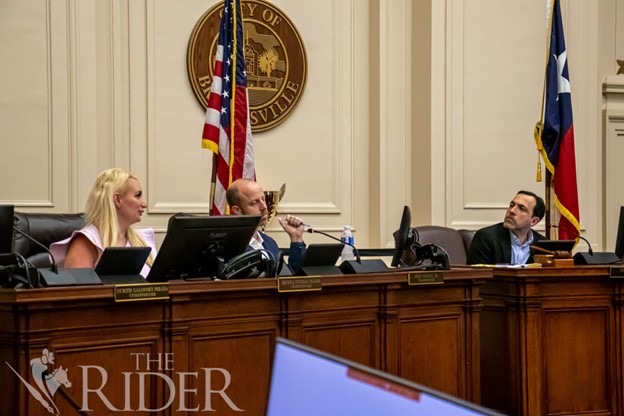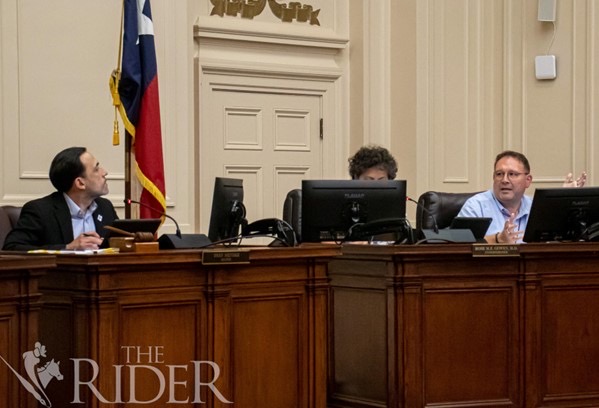
Historic Preservation schedules A, B approved, schedule C tabled
During last Tuesday’s meeting, the Brownsville City Commission voted unanimously to table schedule C from the 2023 Historic Preservation Plan (Property Tax Abatement Incentive Program) and to approve schedules A and B.
Before the public hearing and action on the plan, District 1 City Commissioner Nurith Galonsky Pizaña abstained from the discussion and vote.
“I have a conflict,” Galonsky Pizaña said. “Even though the property was denied at the workshop last time, I just don’t want to participate, in neither the discussion or the vote.”
Juan Velez, historic preservation manager, presented the three schedules and said there were 113 properties included in total for an estimated cost of $124,000.
As previously reported by The Rider, schedule A has 103 properties with a taxable value of $18,059,893. Abatement of taxes “will result in a reduction of approximately $108,813 to the General Fund,” according to documents in the agenda packet.
Schedule B has two properties, a taxable value of $1,187,046 and a general fund impact of $8,213.
Schedule C has eight properties, a taxable value of $1,620,049 and a general fund impact of $7,438.
Not all properties in the third schedule will “achieve conformance to City of Brownsville Municipal Code,” according to the presentation.
Rick Vasquez, the city’s Planning and Redevelopment director, recommended that Mayor Trey Mendez take action on schedule A first since it includes federal, state and local properties, which have all met the requirements and are recommended for approval by the Planning and Zoning Commission and the Historic Preservation Commission.

District 2 City Commissioner Jessica Tetreau motioned to approve schedules A and B. District 4 City Commissioner Pedro Cardenas seconded the motion to approve schedule A but mentioned he failed to see photos of properties listed in schedule B in the packet.
District 3 City Commissioner Roy De Los Santos informed Cardenas that the photos included in the packet were schedule C properties.
Mendez informed Cardenas that the schedule B properties were the ones he owned and then abstained from voting.
When discussing schedule C, Mendez said P&Z did not recommend properties five and six. However, the commission could approve them or any other property listed in schedule C.
De Los Santos said he appreciated that the photos and division of schedule C properties were included in the packet as he requested. However, he also noticed there were defects in almost every single property, yet only two properties were not recommended to be included.
“When I look at the packet and I see ‘defect’ on every single property, and I see federal, local and state substantial rehabilitation, I see no’s across the board for schedule C,” De Los Santos said. “So I’m trying to understand what’s the difference between five and six and the others if they all show defects. And several of those pictures show no signs of activity or active restoration, but they’re being recommended for inclusion where the others are not.”
De Los Santos added that it is not easy for him to see the difference in the packet and asked Mendez to help him understand that.
Mendez then explained the purpose of the historical abatement.
“One is, obviously, you want to try and preserve a property that has historical value,” he said. “The keyword is preserve, right? So, therefore, the purpose of having tax abatements or tax incentives is with the thought that that money is going to be put into the property because historical properties, as Commissioner [at-Large “B” Rose] Gowen knows also, typically, take more money to maintain.”
Mendez then asked Velez to clarify if the properties in schedule C were of concern.
Vasquez responded by stating that the purpose behind the schedule is that there are properties not on the list that do not meet the criteria established in ordinance or by the state program.
“If we’re just being transparent, disclosing to the commission, although they have a recommendation from the Historic Preservation Commission, or don’t have a recommendation, or they were approved by the Planning and Zoning Commission, they still didn’t meet the ordinance requirement that we presently have,” Vasquez said.
De Los Santos replied that he does not see in the packet what the defects are.
“The packet does not illustrate to me that these are the defects, why we’re recommending, ‘No,’” he said. “And I also had a concern because when I look at the pictures, four, five and six specifically, each of those slides says ‘HPC, P&Z did not recommend inclusion.’ But when you look at the chart above, it shows HPC does not recommend inclusion but P&Z does.”

Vasquez clarified that what P&Z actually recommended was whatever the HPC recommended. He added that P&Z did not take the cases individually and evaluate them in its reviews.
“I think the comment was even made that, ‘The HPC does a good job. Let’s follow their recommendations,’” Vasquez said.
De Los Santos argued that the information provided should reflect that since the chart provided in the packet did not. He also said that the slide presented by Vasquez did not match what was in his packet and asked why that was.
After receiving no response to his question, De Los Santos elaborated further.
“Slide in my packet, bullet No. 2, says, ‘HPC/P&Z did not recommend inclusion in Historic Preservation plan,’ and that’s not what’s on the screen now,” he said.
Vasquez explained that with the Kress Building application, No. 5 in schedule C, there are two deficiencies. It does not meet Chapter 94 of the tax code, specifically, the architectural features provision, and the property was not recommended for approval by the HPC.
“But once again, we’re here where I’m seeing things for the first time when I’m expected to take a vote, and I don’t appreciate that,” De Los Santos said.
Vasquez told the commissioner P&Z would figure out why the packet he received was not the same and that he was unsure why it happened since it was submitted through the agenda process.
Tetreau initially motioned to “deny.” Mendez asked her which ones. She replied five and six, then asked what the recommendation was.
Mendez said there was no recommendation. Tetreau then asked which properties were noncompliant. Mendez replied all of them were “noncompliant,” and that the HPC suggested denying the two properties.
De Los Santos said that it did not make sense since there was a lack of explanation as to why the two properties were recommended to be denied when all are “noncompliant.”
Vasquez responded that discussion within the HPC found no evidence of preservation activity in properties five and six.
Gowen then asked Vasquez if the other properties were in compliance with the ordinances, to which Vasquez replied no.
“No. 1 is an example,” Vasquez said. “The state historic preservation office has communicated to the historic preservation officer that that individual is not in compliance with their state plan that qualifies them for 100% abatement locally, but they should be in compliance with their state plan in order to receive the local benefit. Or else, they’d be reduced to a 50% property until they come into compliance.”
Vasquez then informed the commission that properties two, three and seven also showed no evidence of preservation activity.
“But, you see, almost every property, there is no evidence of any preservation activity,” De Los Santos said. “‘But let’s say yes to all of them except five and six.’ I don’t see the rationality.”
Mendez then referred back to Tetreau’s motion and asked her to clarify if her motion was to deny the entire list or only five and six.
She responded that it was a hard decision to make because none of the properties were compliant.
“And I feel very strongly that a preservation effort needs to be made in order to waive your taxes,” Tetreau said. “… So either you participate in the program or you should not be asking for the waiver.”
The commissioner then decided that her motion was to deny all of them, and Cardenas seconded.
City Commissioner At-Large “A” John Cowen Jr. asked Vasquez for what reasons, if any, the HPC moved to approve schedule C.
Vasquez turned to Velez to clarify if there was any reason. Vasquez informed the commission that there was not.
Gowen then asked Vasquez if it was possible that property owners were waiting on the abatement to be able to afford the repairs they were looking for.
Vasquez explained that the improvement should be made first, then evidence of preservation must be provided through receipts and documentation for individuals and their property to be included on the list.
“This program needs to be reevaluated,” Vasquez said. “It’s done on an annual basis. It’s very difficult to evaluate a project where you spent a large amount of money and try to recapture a benefit in a one-year time frame.
“What we probably should be doing is evaluating how much is spent on preservation activity and quantifying that and then bringing the commission a one-to-five-year recommendation to allow the property owner to recapture some of those funds.”
Gowen agreed that she would like to see that change since “it is confusing.”
De Los Santos said that his concern with this process is that there is a disparity in treatment on all the properties and suggested tabling action on schedule C until there is more information. He then motioned to table the schedule.
Mendez then reminded the commission that there was a previous motion made to deny the schedule. The motion failed.
De Los Santos reiterated his motion to table schedule C but, before a vote could proceed, Vasquez asked Mendez for permission to provide more information on the process. He then informed Mendez that if the schedule was to be tabled, they would not make the deadline to get to the other entities, such as the county, the college district and the port, in time for the property owners to be given the abatement.
After further discussion with Vasquez, De Los Santos said the motion to table was still appropriate since he would still be able to “pitch it as a package as it’s already passed first reading to the city,” and it would only be pending a second reading.





